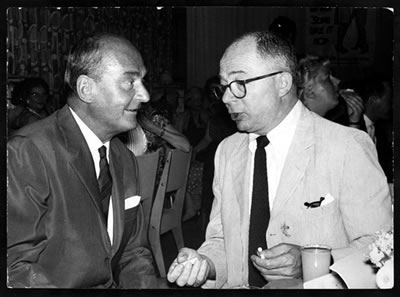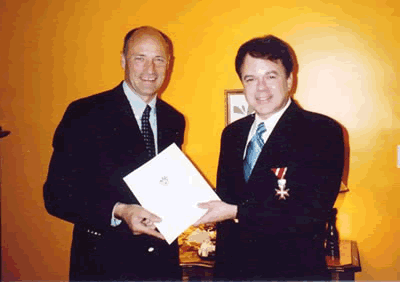The ‘Reel’ Vienna-Hollywood Connection
by Robert Dassanowsky
With international interest in New Austrian Film reaching an impressive level that recalls the influence of Austrian cinema in the early and mid-twentieth century, it is enlightening to explore Hollywood’s unique relationship with Vienna. Much has been told about the significant presence of Austro-Hungarian and Austrian émigrés in Golden Age Hollywood. Their involvement in the creation of the genre American Film is particularly known for screwball comedy, period romantic comedies, and film noir. Little, however, has been written on the long and symbiotic relationship between the two national cinemas.
In 1919, Austrian film mogul Count Sascha Kolowrat signed on two former Austro-Hungarians, Mihály Kertész and Sandor Korda, to create large-scale films that would be modeled after D. W. Griffith’s Intolerance (USA 1916). What resulted was a roster of such spectacular Biblical films employing the proverbial “cast of thousands,” of which Hollywood took immediate notice. Die Sklavenkönigin/The Slave Queen (Austria 1923) became a direct challenge to Cecil B. DeMille, who was in production with his own epic on a similar theme, The Ten Commandments (USA 1923). Austrian film was deemed technically superior and found popular success. It also led to Kertész’s contract with Warner Brothers - and his Hollywood career as Michael Curtiz.

Willi Forst (left) and Billy Wilder in Vienna, 1957
The creation of the stylized musical drama dealing with the sacrifice of love for art - known as the Viennese Film - by screenwriter Walter Reisch and actor/director Willi Forst in the early 1930s, brought global interest to Austria’s new sound film. Forst’s Maskerade/Masquerade (Austria 1934), made an instant star of Paula Wessely in her lead debut, a foremost figure in German language motion pictures and theater for five decades and the wife of actor Attila Hörbiger. Laurence Olivier considered her the greatest film actress of the 20th century, and Bette Davis was known to have studied her performances. The film proved so successful internationally, that Hollywood “borrowed” the story for its 1935 version, Escapade. Subsequently, many of the period musicals and costume dramas in 1930s Hollywood were influenced by the Viennese Film and created by Austrian and German immigrant artists.
The most remarkable Vienna-Hollywood episode occurred just prior to the Anschluss. Germany, Vienna’s most important film market, had made National Socialist racial laws the basis for film import as part of an effort to strangle Austria’s commerce. This resulted in the splitting of Vienna’s film industry: traditional studios provided films that suited German demands, and an independent Emigrantenfilm, which was populated by Austrian and German artists unacceptable to Germany, was co-produced with Hungarian, Czechoslovakian, Dutch and even Swedish studios for international (non-German) distribution.
This unique multicultural cinema featured stars such as Hans Jaray, Franziska Gaal, S.Z. Szakall, Felix Bressart, and Rosy Barsony, and offered some of the best-crafted films of the era. Both MGM and Twentieth Century Fox promised solid investment in Austrian film and planned on five Hollywood/Vienna co-productions in the immediate future as well as around fifteen dubbing commissions per year. Subsequent negotiations had already led to pre-production status for two films to be made in 1937. Even more astonishing was the communication from Joseph Breen, the administrator of Hollywood’s Production Code, who informed Vienna that “[he] is greatly sympathetic to Austria” and would promote Austria’s desires in the Hollywood industry.
But German pressure to reduce the amount of American films in Austria and increase the importation of German-made features, forced Austria to wi thdraw from the project. Nevertheless, Hollywood studios continued to make imitation Austrian-style films, and in the wake of the failed negotiations, Paramount Studios released Champagne Waltz (USA 1937), an imperial Vienna-themed musical comedy that counted Billy Wilder among its writers.
In the four-power division of Vienna following the war, the city’s largest studio complex, Rosenhügel, fell to Soviet control and propaganda use, but it was the U.S. that first permitted true Austrian production. By the founding of the Second Republic in 1955, Vienna was enjoying the largest film production boom in its history. It produced and exported award-winning period dramas (The Angel with the Trumpet, 1948; Eroica, 1949), Alpine Heimatfilms and lavish Agfacolor imperial epics (among them, the “Sissi” films), which competed with and were copied by the Hollywood studio fantasies of the time. These films eventually gave Hollywood a new crop of “imported” stars. In the early 1960s, Walt Disney intended to create a studio unit in Vienna that would create Austrian and Central European-themed features and documentaries for American theatrical and television release. Three films ensued, but the project was halted at his death in 1966.
Following three decades of commercial collapse, experimentation and reinvention, Austrian cinema emerged in the 1990s with a new generation of talent, which took traditional genres, such as the provincial Heimatfilm and the social drama, visually deconstructed them and infused them with political and psychological commentary. By the turn of the century, Austria had also started to recall its cinema history on scholarly and popular levels. Retrospectives and historical documentation brought important achievements to new audiences such as the work of Sascha Hammid, an Austrian cinematographer who was instrumental in the development of IMAX.
New Austrian Film has, in the last several years, become a popular fixture at international film festivals, capturing awards and the imagination of global cineastes. While the maverick work of Michael Haneke, Barbara Albert, Ulrich Seidl, Jessica Hausner, Ruth Mader, Barbara Gräftner, Michael Glawogger, Stefan Ruzowitzky, Harald Sicheritz, Wolfgang Murnberger, Virgil Widrich, and Peter Tscherkassky may not yet be part of corporate Hollywood’s production meetings, it is obvious that American independent and experimental filmmakers are looking towards current Austrian filmmaking as a vision to consider.

Consul General Martin Weiss presenting the Decoration of Honor in Silver to Robert Dassanowsky, Los Angeles, November 21, 2005.
Dr. Robert Dassanowsky is Associate Professor and Chair of Languages and Cultures and Director of Film Studies at the University of Colorado. He is the co-founder and Vice President of both the Austrian American Film Association (AAFA) and the International Alexander Lernet-Holenia Society. His 1996 study, Phantom Empires, is widely regarded as having been instrumental in stimulating new international interest in the Austrian author, Lernet-Holenia.
Prof. Dassanowsky is also active as an independent film producer. In 1999, he re-established Vienna’s postwar Belvedere Film as a Los Angeles/Vienna based production company with his mother, producer and musical arts figure, Elfi von Dassanowsky, one of the original studio founders. Among the company’s co-productions, the dramatic short, Semmelweis (USA/Austria 2001), has garnered international acclaim. Prof. Dassanowsky was named a Carnegie Foundation/Council for the Advancement of Education (CASE) U.S. Professor of the Year for Colorado in 2004. His latest book, Austrian Cinema: A History, the first comprehensive English language survey of Austria’s film art and industry was published in 2005. The Austrian President awarded Dr. Dassanowsky the Decoration of Honor in Silver for Service to the Republic of Austria.
